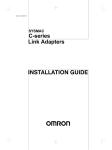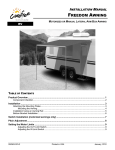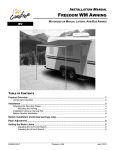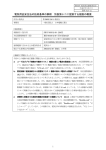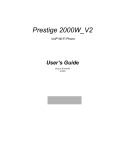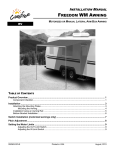Download Hitachi EH-150 User's Manual
Transcript
HITACHI PROGRAMMABLE CONTROLLER RESISTANCE TEMPERATURE DETECTIVE INPUT MODULE(EH-PT4) APPLICATION MANUAL NJI-324(X) WARNING To ensure that the equipment described by this manual. As well as all equipment connected to and used with it, operate satisfactorily and safety, all applicable local and national codes that apply to installing and operating the equipment must be followed. Since codes can vary geographically and can change with time, it is the user’s responsibility to determine which standard and codes apply, and to comply with them. FAILURE TO COMPLY WITH APPLICABLE CODES AND STANDARDS CAN RESULT IN DAMAGE TO EQUIPMENT AND/OR SERIOUS INJURY TO PERSONNEL. INSTALL EMARGENCY POWER STOP SWITCH, WHICH OPERATES INDEPENDENTLY OF THE PROGRAMMABLE CONTROLLER TO PROTECT THE EQUIPMENT AND/OR PERSONNEL IN CASE OF THE CONTROLLER MALFUNCTION. Personnel who are to install and operate the equipment should carefully study this manual and any other referred to by it prior to installation and/or operation of the equipment. Hitachi Industrial Equipment Systems Co., Ltd. constantly strives to improve its products, and the equipment and the manual(s) that describe it may be different from those already in your possession. If you have any questions regarding the installation and operation of the equipment, or if more information is desired, contact your local Authorized Distributor or Hitachi Industrial Equipment Systems Co., Ltd. IMPORTANT THIS EQUIPMENT GENERATES, USES, AND CAN RADIATE RADIO FREQUENCY ENERGY AND, IF NOT INSTALLED AND USED IN ACCORDANCE WITH THE INSTRUCTION MANUAL, MAY CAUSE INTERFERENCE TO RADIO COMMUNICATIONS. AS TEMPORARILY PERMITTED BY REGULATION, IT HAS NOT BEEN TESTED FOR COMPLIANCE WITH THE LIMITS FOR CLASS A COMPUTING DEVICES PURSUANT TO SUBPART J OF PART 15 OF FCC ROULES, WHICH ARE DESIGNED TO PROVIDE PEASONABLE PROTECTION AGAINST SUCH INTERFERENCE. OPERATION OF THIS EQUIPMENT IN A RESIDENTIAL AREA IS LIKELY TO CAUSE INTERFERENCE IN WHICH CASE THE USER, AT HIS OWN EXPENSE, WILL BE REQUIRED TO TAKE WHATEVER MEASURES MAY BE REQUIRED TO CORRECT THE INTERFERENCE. LIMITED WARRANTY AND IMITATION OF LIABILITY Hitachi Industrial Equipment Systems Co., Ltd. (Hitachi) warrants to the original purchaser that the programmable logic controller (PLC) manufactured by Hitachi is free from defects in material and workmanship under normal use and service. The obligation of Hitachi under this warranty shall be limited to the repair or exchange of any part or parts which may prove defective under normal use and service within eighteen (18) months from the date of manufacture or twelve (12) months from the date of installation by the original purchaser which ever occurs first, such defect to be disclosed to the satisfaction of Hitachi after examination by Hitachi of the allegedly defective part or parts. This warranty in expressly in lieu of all other warranties expressed or implied including the warranties of merchantability and fitness for use and of all other obligations or liabilities and Hitachi neither assumes, nor authorizes any other person to assume for Hitachi, any other liability in connection with the sale of this PLC. This warranty shall not apply to this PLC or any part hereof which has been subject to accident, negligence, alternation, abuse, or misuse. Hitachi makes no warranty whatsoever in respect to accessories or parts not supplied by Hitachi. The term “original purchaser”, as used in this warranty, shall be deemed to mean that person for whom the PLC in originally installed. In no event, whether as a result of breach of contract, warranty, tort (including negligence) or otherwise, shall Hitachi or its suppliers be liable for any special, consequential, incidental or penal damages including but not limited to, loss or profit or revenues, loss of use of the products or any associated equipment, damage to associated equipment, cost of capital, cost of substitute products, facilities, services or replacement power, down time costs, or claims of original purchaser’s customers for such damages. To obtain warranty service, return the product to your distributor, or send it with a description of the problem, proof of purchase, post paid, insured, and in a suitable package to: Quality Assurance Dept. Hitachi Industrial Equipment Systems Co., Ltd. 46-1 Ooaza-Tomioka Nakajo-machi Kitakanbara-gun, Niigata-ken 959-2608 JAPAN Copyright 2002 by Hitachi Industrial Equipment Systems Co., Ltd. All Right Reserved – Printed in Japan The Information and/or drawing set forth in this document and all right in and to inventions disclosed herein and patent which might be granted thereon disclosing or employing and the materials, methods, techniques or apparatus described herein are the exclusive property of Hitachi Industrial Equipment Systems Co., Ltd . No copies of the information or drawings shall be made without the prior constant of Hitachi Industrial Equipment Systems Co., Ltd. Hitachi Industrial Equipment Systems Co., Ltd. provides customer assistance in varied technical areas. Since Hitachi does not possess full access to data concerning all of the uses and applications of customer’s products, responsibility is assumed by Hitachi neither for customer product design nor for any infringement of patents or rights of others, which may result from Hitachi assistance. The specifications and descriptions contained in this manual were accurate at the time they were approved for printing. Since Hitachi Industrial Equipment Systems Co., Ltd. Incorporated constantly strives to improve all its products, we reserve the right to make changes to equipment and/or manual at any time without notice and without incurring any obligation other than as noted in this manual. Hitachi Industrial Equipment Systems Co., Ltd. assumes no responsibility for errors that may appear in this manual. As the product works with user program, and Hitachi Industrial Equipment Systems Co., Ltd. cannot test all combination of user program components, it is assumed that a bug or bugs may happen unintentionally. If it is happened: please inform the fact to Hitachi Industrial Equipment Systems Co., Ltd. or its representative. Hitachi will try to find the reason as much as possible and inform the countermeasure when obtained. Nevertheless Hitachi Industrial Equipment Systems Co., Ltd. intends to make products with enough reliability, the product has possibility to be damaged at any time. Therefore personnel who are to install and operate the equipment have to prepare with the countermeasure such as power off switch can be operated independently of the controller. Otherwise, it can result in damage to equipment and/or serious injury to personnel. Safety Precautions Read this manual and related documents thoroughly before installing, operating, performing preventive maintenance or performing inspection, and be sure to use the unit correctly. Use this product after acquiring adequate knowledge of the unit, all safety information, and all cautionary information. Also, make sure this manual enters the possession of the chief person in charge of safety maintenance. Safety caution items are classified as "Danger" and "Caution" in this document. DANGER : Cases where if handled incorrectly a dangerous circumstance may be created, resulting in possible death or severe injury. CAUTION : Cases where if handled incorrectly a dangerous circumstance may be created, resulting in possible minor to medium injury to the body, or only mechanical damage. However, depending on the circumstances, items marked with CAUTION may result in major accidents. In any case, they both contain important information, so please follow them closely. Icons for prohibited items and required items are shown below: : Indicates prohibited items (items that may not be performed). For example, when open flames are prohibited, is shown. : Indicates required items (items that must be performed). For example, when grounding must be performed, is shown. 1. About installation CAUTION l Use this product in an environment as described in the catalogue and this document. If this product is used in an environment subject to high temperature, high humidity, excessive dust, corrosive gases, vibration or shock, it may result in electric shock, fire or malfunction. l Perform installation according to this manual. If installation is not performed adequately, it may result in dropping, malfunction or an operational error in the unit. l Do not allow foreign objects such as wire chips to enter the unit. They may become the cause of fire, malfunction or failure. 2. About wiring REQUIRED l Always perform grounding (FE terminal). If grounding is not performed, there is a risk of electric shocks and malfunctions. CAUTION l Connect power supply that meets rating. If a power supply that does not meet rating is connected, fire may be caused. l The wiring operation should be performed by a qualified personnel. If wiring is performed incorrectly, it may result in fire, damage, or electric shock. 3. Precautions when using the unit DANGER l Do not touch the terminals while the power is on. There is risk of electric shock. l Structure the emergency stop circuit, interlock circuit, etc. outside the programmable controller (hereinafter referred to as PC). Damage to the equipment or accidents may occur due to failure of the PC. However, do not interlock the unit to external load via relay drive power supply of the relay output module. CAUTION l When performing program change, forced output, RUN, STOP, etc., while the unit is running, be sure to verify safety. Damage to the equipment or accidents may occur due to operation error. l Supply power according to the power-up order. Damage to the equipment or accidents may occur due to malfunctions. 4. About preventive maintenance DANGER l Do not connect the , of the battery in reverse. Also, do not charge, disassemble, heat, place in fire, or short circuit the battery. There is a risk of explosion or fire. PROHIBITED l Do not disassemble or modify the unit. These actions may result in fire or malfunction. CAUTION l Turn off the power supply before removing or attaching module/unit. Electric shock, malfunction or failure may result. Revision No. Content Date Manual No. Table of contents 1. Introduction 1-1 to 1-4 1.1 Before Use ・・・・・・・・・・・・・・・・・・・・・・・・・・・・・・・・・・・・・・・・・・・・・・・・・・・・・・・・・・・・・・ 1-2 1.2 Precaution on Use ・・・・・・・・・・・・・・・・・・・・・・・・・・・・・・・・・・・・・・・・・・・・・・・・・・・・・・・ 1-3 1.3 Features ・・・・・・・・・・・・・・・・・・・・・・・・・・・・・・・・・・・・・・・・・・・・・・・・・・・・・・・・・・・・・・・・ 1-3 1.4 Principle of Operation ・・・・・・・・・・・・・・・・・・・・・・・・・・・・・・・・・・・・・・・・・・・・・・・・・・・ 1-4 2. Structure and Nameplate 2-1 2.1 Structure and Name of Each Part ・・・・・・・・・・・・・・・・・・・・・・・・・・・・・・・・・・・・・・・・・・ 2-1 3. Specification 3-1 to 3-2 3.1 Specification list ・・・・・・・・・・・・・・・・・・・・・・・・・・・・・・・・・・・・・・・・・・・・・・・・・・・・・・・・ 3-1 3.2 Terminal layout and internal circuit ・・・・・・・・・・・・・・・・・・・・・・・・・・・・・・・・・・・・・・・ 3-2 4. Block Diagram 4-1 4.1 Internal Block Diagram ・・・・・・・・・・・・・・・・・・・・・・・・・・・・・・・・・・・・・・・・・・・・・・・・・・ 4-1 5. External Wiring 5-1 5.1 Resistance Temperature Detective Connection Method and External Wiring ・・・・・・・・・・・・・・・・・・・・・・・・・・・・・・・・・・・・・・・・・・・・・・・・・・・・・・・・・・・・・・・・・・・・・・・・・ 5-1 6. Setting 6-1 6.1 Setting of Temperature Range ・・・・・・・・・・・・・・・・・・・・・・・・・・・・・・・・・・・・・・・・・・・ 6-1 7. Collection of Temperature Data 7-1 to 7-7 7.1 I/O Allocation ・・・・・・・・・・・・・・・・・・・・・・・・・・・・・・・・・・・・・・・・・・・・・・・・・・・・・・・・・・ 7-1 7.2 Temperature Data ・・・・・・・・・・・・・・・・・・・・・・・・・・・・・・・・・・・・・・・・・・・・・・・・・・・・・・ 7-2 7.3 Example of Calculation ・・・・・・・・・・・・・・・・・・・・・・・・・・・・・・・・・・・・・・・・・・・・・・・・・・ 7-4 7.4 Correspondence Table between Temperature and Temperature Data ・・・・・・・・ 7-5 8. Error Detection Processing 8-1 to 8-2 8.1 Measured Temperature Range Over ・・・・・・・・・・・・・・・・・・・・・・・・・・・・・・・・・・・・・・ 8-1 8.2 Treatment for Sudden Change of Temperature Conversion Data ・・・・・・・・・・・・ 8-2 9. Mounting 9.1 9.2 9.3 9.4 9-1 to 9-2 Installation・・・・・・・・・・・・・・・・・・・・・・・・・・・・・・・・・・・・・・・・・・・・・・・・・・・・・・・・・・・・・ 9-1 Mounting Method・・・・・・・・・・・・・・・・・・・・・・・・・・・・・・・・・・・・・・・・・・・・・・・・・・・・・・・ 9-1 Maintenance and Inspection ・・・・・・・・・・・・・・・・・・・・・・・・・・・・・・・・・・・・・・・・・・・・・ 9-1 Precautions on External Wiring ・・・・・・・・・・・・・・・・・・・・・・・・・・・・・・・・・・・・・・・・・・ 9-2 10. Example of Programming 10-1 to 10-4 10.1 Example of Programming 1 ・・・・・・・・・・・・・・・・・・・・・・・・・・・・・・・・・・・・・・・・・・・・10-1 10.2 Example of Programming 2 (Offset adjustment) ・・・・・・・・・・・・・・・・・・・・・・・・・10-4 11. Troubleshooting 11-1 11.1 The Allocation Error “41” is indicated in CPU ・・・・・・・・・・・・・・・・・・・・・・・・・・・11-1 11.2 Data Error in a Specific Channel ・・・・・・・・・・・・・・・・・・・・・・・・・・・・・・・・・・・・・・・11-1 11.3 Data Error in All Channels ・・・・・・・・・・・・・・・・・・・・・・・・・・・・・・・・・・・・・・・・・・・・11-1 12. Appendix 12-1 12.1 Calculation of External Wiring Resistance ・・・・・・・・・・・・・・・・・・・・・・・・・・・・・・12-1 1.Introduction 1. Introduction This manual describes how to operate the EH-PT4 (Resistance Temperature Detective input module) properly, which is one of the special function module of EH-150 Programmable Logic controller(PLC). Carefully read this manual to familiarize yourself with the procedures respectively of installation, operation, and maintenance and inspection. Please be sure to read the related application manuals, too. Table 1.1 Reference Manual list No. 1 Document Manual No. About the detailed operation method of the programming unit 1) Instruction word programmer (PGM-CHH) Instruction word programmer manual NB981X* 2) Portable indication programmer (PGM-GPH) Portable indication programmer manual NB982X* 3) LADDER EDITOR FOR WINDOWS (HLW-PC3) Programming manual NJI-206X* 4) LADDER EDITOR FOR DOS (HL-AT3E) Programming manual 2 NB335X* EH-150 APPLICATION MANUAL NJI-280X* “*” means revision of manual and up to A, B, C in order. Reference What is Resistance Temperature Detective(RTD)? This is also called as “Resistance Thermometer Sensor”. Refers to the device measuring the temperature by using the metal’s property that its electric resistance changes with the temperature and is often made of Pt 100 ohm (platinum with a resistance of 100 ohm at 0 °C. As for the principle of the measurement, by feeding a constant current of 1 through 5 mA ( 2 mA in this module) to a resistance temperature detective, the change of resistance due to that of temperature is measured as the change of voltage. Use a resistance temperature detective complying with IEC 751 for this module. 1-1 1.Introduction 1.1 Before Use The resistance temperature detective input module (hear after EH-PT4) has been carefully manufactured, but you are kindly advised to make the following checks on receipt of it. (1) The type and specification of the module are as specified by the order. (2) No damage is caused to the equipment during transport. If any failures is found, contact the sales office. (3) The accessories listed in Table 1.2 are supplied. Table 1.2 Package contents list of resistance temperature detective input module No. Contents Quantity 1 Resistance temperature detective input 1 module body 2 I/O cover 1 3 Operation manual 1 1-2 Remarks 1.Introduction 1.2 Precautions on Use (1) Before the installation and removal of the module, turn off the power. (2) Before the connection of the external wiring and removal of the terminal board, turn off the power. (3) The terminal board handles fine signals. Therefore upon handling the module or wiring, be careful not to apply a voltage on it by mistake or leave it under the influence by excessive static electricity. (4) Upon the connection of external wiring, before work, eliminate static electricity by touching a grounded metal bar to prevent it from being damaged by excessive static electricity charged on the human body. To prevent a malfunction due to static electricity do not touch the terminal during power feeding. (5) When the connection cable to a resistance temperature detective is cut, the temperature conversion data becomes abnormal. If the temperature data exceeds the normal range to protect the external devices, adjust the control system so that the external devices operate with safety. (6) If the resistance of a resistance temperature detective (RTD) exceeds 250 ohm (corresponding to about 410 °C ) at PT100, or 2500 ohm(corresponding to about 410 ºC ) at PT1000, except when the line is broken, the temperature conversion data is unstable. 1.3 Features (1) EH-PT4 applies for two kinds of platinum resistance temperature detectives: Pt100(IEC 751) and Pt1000. (2) Temperature measurement range: Three kinds of ranges(selected by switch) Resistance temperature Temperature measurement Accuracy(°C) detectives range(ºC) Pt100 -50 to + 400 ±3 Pt100 -20 to + 40 ± 0.5 Pt1000 -50 to + 400 ±6 (3) Because the accuracy of the temperature measurement range -20 to +40ºC is ± 0.5 ºC, EH-PT4 is suitable for exact measurement. (4) Temperature conversion data: signed 15 bits. (5) Number of Inputs: 4 channels, 3-wire system. 1-3 2. Structure and Nameplate 2. Structure and Nameplate 2.1 Structure and Name of Each Part Name and function of each part Type EH-PT4 Weight Approx. 180 g Dimensions(mm) 1) Lock Button 30 95 2) I/O cover 4) Setting Switch 100 3) Terminal Block Name No. 1) Lock button 2) I/O cover 3) Terminal block 4) Setting Switch Function This is used when removing the module from the base unit. After it is installed to the base unit, the fixation can be reinforced using screws. In this case, use M4x10mm screws. This is the cover attached to the terminal block area. This is the terminal block for connecting input signals. The terminal block can be connected or disconnected. This is used for setting of temperature range. Item Detailed explanation The module receives input signals from outside. Operation explanation While the module energized, The CPU module recognizes the status of the loaded module and when it matches the I/O assignment information included in the user program. Input information is received according to the contents of the user program. Terminal block The screws for the terminal block are M3 screws. Use a crimp terminal that fits the screw diameter. The maximum thickness of the cable should be only up to 0.75 SQ. The recommended crimp terminal is indicated below. 6 単位:mm 2-1 Unit: mm Remarks Refer chapter 6. Remarks 3.Specification 3. Specification 3.1 Specification list Table 3.1 shows the specifications of EH-PT4. Table 3.1 Specification Item Specification Type Resistance temperature detective EH-PT4 Platinum resistance temperature detective Pt100 (IEC 751) Platinum resistance temperature detective Pt1000 Temperature conversion data Signed 15 bits (In normal state the lowest bit is always “0”.) Accuracy -20 to + 40 °C (Pt100) ± 0.5 °C (Note 1) -50 to + 400 °C (Pt100) ± 3 °C -50 to + 400 °C (Pt1000) ± 6 °C Temperature measurement range -20 to +40 °C / -50 to +400 °C (2mA constant current method) Number of channels 4 channels Conversion time About 1s / 4 channels Insulation Between channel and PC Photocoupler insulation Between channels Non-insulation External power supply 24V DC ±10% 100mA max. Internal current consumption 200mA max. (5 V DC) External wiring resistance 400 ohm max. / channel External wiring Shielded wire Additional function Linearization Error detection -20 to +40 °C (Pt100) H7FFF is outputted at –25 °C or less, or at +45 °C or higher -50 to +400 °C (Pt100/ Pt1000) H7FFF is outputted at –60 °C or less, or at +410 °C or higher Processing for disconnection (Note 2) H7FFF is outputted to channel. Note 1: The accuracy is the value when 10 minutes pass after the start of power feeding. Just after power is fed, the value may increase slightly. Because a resistance temperature detective has an error, confirm it beforehand. Note 2: This is the case when the current terminal wiring is broken. In case the voltage terminal wiring is broken, the data becomes unspecified. (“H” of “H7FFF” means the following data is hexadecimal.) 3-1 3.Specification 3.2 Terminal layout and internal circuit Terminal layout Internal circuit No. Signal name A0 RTD PT100 IN EH-PT4 b0 B0 2) B0 b0 10) 3) b1 11) 4) B1 5) b2 6) B2 1) 2) 3) 12) 4) 13) 7) b3 14) 8) B3 9) 24V DC+ 5) 6) 15) 10) A0 16) 11) NC 12) A1 13) NC 14) A2 15) NC 16) A3 7) 8) 17) 9) 18) 17) NC 18) 24V DC- A3 RTD + B3 b3 24VDC+ Internal current 1) + Internal power circuit 24VDC- Note 1) Current terminals and a voltage terminals of unused channels should be wired. By this wiring read data becomes H7FFF. 3-2 4. Block Diagram 4. Block Diagram 4.1 Internal Block Diagram Figure 4.1 shows the internal block diagram. EH-PT4 External wiring A0 control Counter B0 A3 RTD b3 B3 Constant current circuit Each part Switch circuit Photocoupler insulation CPU Bus Timing V/F conversion (Note) ・・・ Linearize Input conversion circuit RTD b0 Internal Power Supply circuit Shielded wire External grounding 24 V DC+ 24 V DC− External power 24V DC Figure 4.1 Internal Block Diagram Note: V/F conversion refers to the conversion of voltage(V) to frequency(F). 4-1 5. External Wiring 5. External Wiring 5.1 Resistance Temperature Detective Connection Method and External Wiring × b0 × RTD × B0 × × × × A1 B1 × External wiring(Note1) Use a shielded cable NC NC b2 × A2 B2 × NC × × b3 × A3 × RTD A0 to 3 : Current terminal B0 to 3: Current terminal b0 to 3: Voltage terminal b1 × RTD A0 Make a short-circuit on unused channel shown as the figure. The temperature data becomes H7FFF. B3 × NC +24V × -24V × Grounding (Note2) External power supply 24VDC Figure 5.1 External Wiring Note 1: The external wire length shall be less than 200 m for each channel. In addition, the total resistance of the wires of each channels to be connected to the current terminals (A0 to A3, B0 to B3) shall be less than 400 ohm. Note 2: Use shielded cable and connect shielded to functional earth on the both sides or one side, which depends on the noise environment. Note 3: The earth terminal on the power supply module and External power supply 24 VDC must be connected to the functional earth. When functional earth area doesn't do, temperature data sometimes become unstable. The data becomes unspecified. 5-1 6. Setting 6. Setting 6.1 Setting of temperature range This module can be set to three temperature ranges by the dip switch shown in below. Table 6.1 Temperature rage setting Temperature Setting switch measurement range ON Pt100 1,2,5 ON -20 to +40 °C OFF Pt100 1 2 3 4 5 6 7 8 ON 3,6 ON -50 to +400 °C OFF Pt1000 1 2 3 4 5 6 7 8 ON 4,7 ON -50 to +400 °C OFF 1 2 3 4 5 6 7 8 Note: Do not use the setting which is not written in the table, because the temperature data becomes undefined. Setting switch (Switch 1) 6-1 7. Collection of Temperature Data 7. Collection of Temperate Data 7. 1 I/O Allocation The temperature data of each channel is collected in the CPU as the temperature conversion data corresponding to the temperature. (1) I/O assignment The I/O assignment shall be set as “WX4W" by your programming software or the peripheral equipment. (2) I/O allocation Depending on the module installation position, the temperature conversion data is stored in the word input number shown below. WX□□n0 Channel 1 temperature conversion data 1 Channel 2 temperature conversion data Channel 3 temperature conversion data Channel 4 temperature conversion data 2 3 Figure 7.1 The setting of □□n is determined by the module installation position, as shown below. Slot number EH-PT4 0 AVR •••••••••• n CPU Allocation address WX□n□ Word number (0 to 3) Slot number (0 to 7) Unit number (0 to 1) Figure 7.2 7-1 7. Collection of Temperate Data 7.2 Temperature Data (1) Content of temperature conversion data [range : -50 to +400 °C] (Pt100/ Pt1000) The meaning of the each bit( b0 to b15) of temperature conversion data (in WX**) is as shown below. The sum of the bit “1” is the measured temperature. b15 b14 b13 b12 b11 b10 b9 -800 200 400 50 100 b8 12.5 25 b7 b6 3.125 6.25 b5 b4 0.781 1.563 b3 0.195 0.391 b1 b2 0.0488 0.0977 <For example> b0 (°C) 0.0244 Note) (1) HF800 =“1111 1000 0000 0000" (HF) (H8) (H0) (H0) -800 + 400 + 200 + 100 + 50 = -50 °C (2) H0600 =“0000 0110 0000 0000" (H0) (H6) (H0) (H0) 25 + 12.5 = 37.5 °C When an input error occurs( below -51°C and over 410 °C), the temperature conversion data is H7FFF. The following relation exits between temperature conversion data and actual temperature. Temperature (℃) = Temperature conversion data(signed decimal data) 40.96 Note) “b0” is always “0” in normal time. Relation between the temperature and temperature conversion data a)Temperature conversion data(hexadecimal) -50 to +400 °C H4000 H3000 H2000 H1000 H0800 -50 0 50 100 200 300 400 HF800 Figure 7.3 7-2 Temperate(°C) 7. Collection of Temperate (2) Content of temperature conversion data [range : -20 to +40 °C] (Pt100) The meaning of the each bit( b0 to b15) of temperature conversion data (in WX**) is as shown below. The sum of the bit “1” is the measured temperature. b15 b14 b13 b12 b11 b10 b9 -80 20 5 1.25 10 40 b8 2.5 b7 b6 0.3125 0.625 b5 0.78125 0.15625 b4 b3 b2 b1 b0 0.1953125 0.0488281 0.390625 (°C) 0.0976562 0.024414 Note) <For example> (1) HE000 = “1110 0000 0000 0000" (HE) (H0) (H0) (H0) -800 + 40 + 20 = - 20 °C (2) H0600 =“0000 0110 0000 0000" (H0) (H6) (H0) (H0) 2.5 + 1.25 = 3.75 ℃ When an input error occurs( below -25°C and over 45°C), the temperature conversion data is H7FFF. The following relation exits between temperature conversion data and actual temperature. Temperature (°C) = Temperature conversion data(signed decimal data) 409.6 Note) “b0” is always “0” in normal time. Relation between the temperature and temperature conversion data b)Temperature conversion data(hexadecimal) -20 to +40 °C H4000 H3000 H2000 H1000 H0800 -20 0 5 10 20 30 40 HE000 Figure 7.4 7-3 Temperate (°C) 7. Collection of Temperate Data 7.3 Example of Calculation The program shown below as an example converts the temperature conversion data in WR0 to BCD 4 digit data in WM6. In case the temperature is minus, the bit internal output R0 will be turned on. EXT (DM000,WR0000) (1) DM000 = DM000 S* 100 (2) DM002 = DM000 S/ 4096 (3) R0 = DM002 S< 0 (4) ABS (WM004,WM002) (5) BCD (WM006,WM004) (6) (1) Because the calculation with sign is that by double words, extend the word temperature conversion data(WR0) to double word data(stored in DM0). (2) (3) Calculate by the expression mentioned on previous page. Because the calculation with decimal point (dividing by 40.96) is not possible, multiply the numerator with 100 (2) and then divide by 4,096(3). (4) When the temperature data (result of calculation) is minus, the R0 is turned on. (5) Turn to an absolute variable (for plus temperature data, use as it is and for minus temperature data remove the sign to turn it to a plus value.) (Use WM0 because the result of calculation can be incorporated in a word (less than 16 bits). (6) WM 4 is converted to BCD 4 digits vaule(WM6). 7-4 7.Collection of Temperature Data 7.4 Correspondence Table between Temperature and Temperature Data (1)Pt100/Pt1000 -50 to +400 ºC range Table 7.4.1 Pt100 -50 to +400 ºC range Temperature conversion data Temperature Decimal Hexadecimal data data ( ºC) Note1) -60 -55 -50 -45 -40 -35 -30 -25 -20 -15 -10 -5 0 5 10 15 20 25 30 35 40 45 50 55 60 65 70 75 80 85 90 95 100 63078 63283 63488 63693 63898 64102 64307 64512 64717 64922 65126 65331 0 205 410 614 819 1024 1229 1434 1638 1843 2048 2253 2458 2662 2867 3072 3277 3482 3686 3891 4096 F666 F733 F800 F8CC F999 FA66 FB33 FC00 FCCC FD99 FE66 FF33 0000 00CC 0199 0266 0333 0400 04CC 0599 0666 0733 0800 08CC 0999 0A66 0B33 0C00 0CCC 0D99 0E66 0F33 1000 Pt100 resistance (Ω) Note 2) Temperature Decimal data ( ºC) Hexadecimal data Pt100 resistance (Ω) Note 2) 1199 1333 14CC 1666 1800 1999 1B33 1CCC 1E66 2000 2199 2333 24CC 2666 2800 2999 2B33 2CCC 2E66 3000 3199 3333 34CC 3666 3800 3999 3B33 3CCC 3E66 4000 4199 142.29 146.06 149.82 153.58 157.31 161.04 164.76 168.46 172.16 175.84 179.51 183.17 186.82 190.45 194.07 197.69 201.29 204.88 208.45 212.02 215.57 219.12 222.65 226.17 229.67 233.17 236.65 240.13 243.59 247.04 250.48 Note1) 72.33 78.32 80.31 82.29 84.27 86.25 88.22 90.19 92.16 94.12 96.09 98.04 100.00 101.95 103.90 105.85 107.79 109.73 111.67 113.61 115.54 117.47 119.40 121.32 123.24 125.16 127.07 128.98 130.89 132.80 134.70 136.60 138.50 110 120 130 140 150 160 170 180 190 200 210 220 230 240 250 260 270 280 290 300 310 320 330 340 350 360 370 380 390 400 410 4506 4915 5325 5734 6144 6554 6963 7373 7782 8192 8602 9011 9421 9830 10240 10650 11059 11469 11878 12288 12698 13107 13517 13926 14336 14746 15155 15565 15974 16384 16794 Note 1) At the range from -50 to +400 ºC of Pt100, the input temperature range is from -50 to +400 ºC. But the temperature data output is from -60 to + 410º C. Note 2) In case of Pt1000, the resistance is 10 times of PT100. 7-5 7.Collection of Temperature Data (1)Pt100 -20 to +40℃ range T a b l e 7 . 4 . 2 P t 1 0 0 - 5 0 t o + 4 0 ºC r a n g e T e m p e r a t u r e c o n v e r s i o n d a t a Temperature ( ºC) Note1) Decimal data Hexadecimal data Pt100 resistance (Ω) -25 -20 -15 -10 -5 0 5 10 15 20 25 30 35 40 45 55296 57344 59392 61440 63488 0 2048 4096 6144 8192 10240 12288 14336 16384 18432 D800 E000 E800 F000 F800 0000 0800 1000 1800 2000 2800 3000 3800 4000 4800 90.19 92.16 94.12 96.09 98.04 100.00 101.95 103.90 105.85 107.79 109.73 111.67 113.61 115.54 117.47 Note 1) At the range from -20 to +40 ºC of Pt100, the input temperature input range is from -20 to +40 ºC. But the temperature data output is from -25 to +45 ℃. 7-6 8. Error Deception Processing 8. Error Detection Processing 8.1 Measured Temperature Range over (1)Interlock If temperate conversion data is over the measuring range or current terminal wiring is disconnected, the temperature conversion data becomes H7FFF. After this data is read, it is necessary to make a program externally for the treatment for an error. Example of an error detection program WM000 = H0000 M0000 = WX000 == H7FFF M0001 = WX001 == H7FFF M0002 = WX002 == H7FFF M0003 = WX003 == H7FFF M0008 = WM000 <> H0000 The program checks for error data. When one error data is found, M8 is turned on. M0008 Yb Xa For error data, Yb is turned on. Xa is for reset. Yb Please take a proper countermeasure by using the coil Yb at error detection (M8 ON). Set the numbers of the sections “a” and “b” corresponding to the actual system. 8-1 8. Error Detection Processing 8.2 Treatment for a Sudden Change of Temperature Conversion Data When the temperature conversion data is changed suddenly due to the disconnection of external wiring or influence of noise, the system judges it to be an abnormal condition. In the example shown below, every scanned data is read in. If a change of 5ºC(Note) or more from the previously read data is found, the condition is judged to be abnormal and data is aborted. Note: Change each value to your system. Example of program 1) Every scanned data is read in and the data is stored in DR0 and DR2. DR000 == DX000 DR002 == DX002 2) R7E3 For only the initial scanned data, put the read into the previous data(DR8 to DRA). DR008 == DR000 DR00A == DR002 3) WR0008 ABS 4) 5) WR0009 - WR0001 == WR000A - WR0002 (WR000A , WR000A) WR000B ABS == (WR0009 , WR0009) WR000A ABS The absolute value of the difference between the previous data and read data is calculated. WR0008 - WR0000 (WR0008 , WR0008) WR0009 ABS == == WR000B - WR0003 (WR000B , WR000B) WR0008 < H00CC WR0010 == WR0000 WR0009 < H00CC WR0011 == WR0001 WR000A < H00CC WR0012 == WR0002 WR000B < H00CC WR0013 == WR0003 If the difference between the previous data and read data is less than 5ºC, put the read data into WR10 to WR13. In the following program, the values of WR10 to WR13 are treaded a s normal value. Updates the previous data. When an error occurred, the data is not updated and instead the previous data is held. DR0008 == DR0010 DR000A == DR0012 In the example of this program, no protective action or warning against abnormal data is performed. Make additional circuits depending on the situation. 8-2 9. Mounting 9. Mounting 9.1 Installation (1) EH-PT4 module can be installed on both the basic base and expansion base. (2) Precaution on installation Upon the installation of the EH-150 series, consider the operability, maintainability and environment. (a) For use at proper ambient temperature range • Secure a sufficient space allowing a good ventilation. • Do not install the module just over a device generating a great amount of heat(such as heater, transformer and large capacity resistor). • If the ambient temperature around the module exceeds 55 °C, set a fan or air conditioner to keep the temperature below 55 °C. (b) Do not install the module in panel provided with a high-voltage device. (c) Keep more than 300 mm away from a high-voltage line and power line. (d) Installing the basic base 1,000 mm through 1,600 mm from the floor improves the operability. (e) Secure a clearance of more than 50 mm between the upper and lower sections of the module for ventilation and maintenance. For the right and left directions, secure a clearance of more than 10 mm. (f) Never pull out or insert a alive line of the module. 9.2 Mounting Method (1)Checking a connector Before and after the installation, check the following two points. (a) Is there an abnormality on the connector of the basic base or extensive base? (b) Is there an abnormality in the connector or the module side? (2)Confirming the external wiring Before running, confirm the following items: (a) Check that the connection of the external wiring is proper. (b) Check that the external wiring terminal board and the module are fastened securely with screws. 9.3 Maintenance and Inspection Perform periodic inspection every six months according to the procedure mentioned below. (1) Remove dust and dirt off the terminal board. (2) Confirm that the fixing screws of the external wiring terminal board and module are tightened firmly. 9-1 9. Mounting 9.4 Precautions on External Wiring Because the external wiring of the EH-PT4 handles fine signals, be sure to use a shielded wire to suppress the influence of external noise and place the wire separately from the power line and signal line of different voltage. Wiring cable (shielded wire) of EH-PT4 module Wiring cable (shielded wire) of 300 mm or more EH-PT4 module Other signal cables Other signal cables Power cable Metallic conduit Note) Weld joints of metallic conduits and ground the welded metallic conduits. (Grounding in accordance with local legal requirements) Figure. 9.1 Wire Separation by Conduits or Ducts Caution Use an external power supply which the over current protection character is as below Over current detection Output voltage Load current Figure. 9.2 Over current protection character 9-2 10. Example of Programming 10. Example of Programming 10.1 Example of Programming 1 (1)Control contents (a) The program keeps the temperature of a liquid in a bath 10 to 12ºC higher than that of ambient air temperature. (b) When the temperature difference between the upper part and the lower part of the liquid is 3ºC or higher, the program turns a stirrer on. (c) When the temperature of the liquid exceeds 50 ºC or the temperature difference between the upper part and the lower part of the liquid exceeds 8 ºC, the program turns a temperature error lamp on to indicate an error and starts a cooler. (d) When error data is found, the program turns a data error lamp on and starts the cooler. (e) When error data is found, the program turns a data error lamp on and starts cooler. (f) When an error occurs, the program stops a heater. Motor temperature Air temperature Motor Stirrer Lamp indication Cooler Motor error Temperature at the upper part of the liquid Heater Tempera -ture error Data error - Platinum resistance temperature detective PT100 Temperature at the lower part of the liquid Figure 10.1 External device (2) Configuration and allocation 0 1 2 3 4 EH-PT4 DUM16 DUM16 Y16 CPU AVR DUM16 Install EH-PT4 on the fourth slot. Use the relay output module installed on the slot 0 to output to the external device. Basic base Figure 10.2 PLC configuration Setting of temperature range Pt100 , -50 to +400 ºC Y0: Motor Y1: Cooler Y2: Heater Y3: Motor error lamp Y4: Temperature error lamp Y5: Data error lamp WX40: Air temperature WX41: Temperature at the upper part of the liquid WX42: Temperature at the lower part of the liquid WX43: Motor temperature SW1 ON OFF 10-1 1 2 3 4 5 6 7 8 10. Example of Programming (3)Program The program stores the temperature data for 4 channels in the internal output. DR0000 = DX0040 (1) DR0002 = DX0042 (2) (3) Data check WM0000 = H00000 SS0 M0000 = WR0000 == H7FFF M0001 = WR0001 == H7FFF M0002 = WR0002 == H7FFF M0003 = WR0003 == H7FFF M0004 = WM0000 <> H0000 When an error is found, the program turns M4 on. The program stores the absolute value of the temperature difference between the upper part and the lower part of the liquid in WR4. WR0004 = WR0001 - WR0002 ABS (WR0004 , WR0004) (4) (5) R0000 = H007C <= WR0004 R0001 = H0148 <= WR0004 When the temperature difference is 8ºC or higher, the program turns R0 on. R0002 = H1000 <= WR0003 When the motor temperature is 100ºC or higher, the program turns R2. on R002 (6) R003 When the temperature at the upper part of the liquid is 50ºC or higher, the program turns R3 on. When the temperature at the lower part of the liquid is 50ºC or higher, the program turns R4 on. R004 R0003 = H0800 <= WR0001 R0004 = H0800 <= WR0001 (7) WR0005 = WR0001 - WR0000 R0005 = WR0001 <= WR0000 R0006 = WR0005 <= H0198 R0007 = H01EC <= WR0005 R0000 SS0 (8) R0001 SS0 Y0000 Y0003 (9) 10-2 The program stores the difference between the temperature at the upper part of the liquid and the air temperature in WR5. When the air temperature is higher than the temperature at the upper part of the liquid, the program turns R5 on. When the temperature difference is 10ºC or lower, the program turns R6 on. When the temperature difference is 10ºC or higher, the program turns R7 on. If R0 or R1 turns on, turn the motor for a minute. However, if Y3 turns on, do not turn the motor. 10.Program (10) (11) R002 Y0003 = 1 When R2 is turned on, the program turns the motor error lamp on. Y0004 = 1 Turn on any one of R1, R3, R4, R7 and M4 to turn on the cooler and turn off the heater. R001 R003 Y0002 = 0 R004 R007 M004 (12) R001 Y0001 = 1 Turn on any one of R1, R3 and R4 to light the temperature abnormality lamp. Y0005 = 1 Turn on M4 to abnormality lamp. R003 R004 (13) M004 R005 (14) the data Turn on either R5 or R6 to turn on the heater and turn off the cooler. Y0002 = 1 R006 light Y0004 = 0 10-3 10. Program 10.2 Example of Programming 2 (Offset adjustment) The resistance temperature detective itself has an built-in error, therefore an offset error may occur in temperature conversion data. An offset error occurs due to the change with the passage of time also. An example of correction by programming in this case is shown below. However, because an actual offset value is not always a specified value, it cannot be corrected completely. The offset error refers to the deviation of any temperature conversion data from the reference value(Note) in a specified rate. (The offset error means the constant deviation from the reference value.) Example of offset Temperature conversion data + side offset A A Note: Measure a reference value using a measuring device with a higher accuracy than EH-PT4. Or connect a resistor with a high accuracy instead EH-150 of the resistance temperature device temperature and obtain a direct offset error. For the conversion data relationship between the temperature and resistance, see Table 7.2. - side offset Reference value Temperature( ºC) A: Offset error (1) Adjustment procedure (a) Decide whether an offset error is on + or – side toward a reference value. (b) Obtain a temperature conversion data corresponding to offset error. Offset error Temperature conversion data 1 ºC H0028 or H002C 2 ºC H0050 or H0054 3 °C H0078 or H007C 4 °C H00A0 or H00A4 5 °C H00CC or H00D0 (c) If offset error is on + side toward the reference value, subtract the value obtained in (b) from the temperature conversion data. If it is on – side, add the value obtained in (b) to the temperature conversion data. (2) Example of programming (The configuration is the same as the example of programming 1) If the channel 2 has + 2 °C offset, subtract H0050 from the temperature conversion data WX0042. WR0000 = WX0040 WR0001 = WX0041 WR0002 = WX0042 - H0050 WR0003 = WX0043 10-4 11. Troubleshooting 11 Troubleshooting If you have some problems, please find the cause according to the following countermeasures. If the problem is not solved despite this countermeasures, contact the sales office. If a spare unit is available, replace and see the condition. 11.1 The Allocation Error “41 ” is indicated in CPU. Error code “41” is “I/O information verify error”. I/O assignment information and actual loading of module do not much. (Error codes are output as a hexadecimal to the WRF000.) (1) Check the I/O assignment in CPU. (2) Check the connection between the module and base. (3) A defect may occur from the other modules. Check the other modules. too 11.2 Data Error in a Specific Channel The type of data errors are (a) unstable data, (b) loss of accuracy and (c) that data is H7FFF. (1) Check if the wire for the data undergoing an error in its amount is connected properly. (2) Check if the wiring is placed on the same route as the power line (if so, noise is induced.) (3) Check if the terminal board screws are tightened securely. (4) Check if the resistance temperature detective is the PT100/PT1000 complying with IEC 751. (5) Check if the external wiring resistance (current terminal wiring ) is less than 400 ohm. (6) Check if a measured temperature is out of the specification rage of EH-PT4. 11.3 Data Error in All Channels The data of all channels may become H7FFF. (1) If there is an unused channel, check if its current terminal is correct. (2) Check the output voltage of external power supply. Check if the wiring of the current terminal is disconnected. (3) Check the capacity of the external power supply.(Output current 1A or more) [Precautions] (1) Before replacing the module, be certain to turn off the power. (2) Upon returning a module for a repair, notify us of the details of the abnormal condition. (3) For troubleshooting, the following tools are necessary. (a) Phillips screwdriver and slotted screwdriver (+ / -) (b) Digital multi-meter, circuit tester (c) Oscilloscope (necessary depending on the case) 11-1 12. Appendix 12. Appendix 12.1 Calculation of External Wiring Resistance Assuming that the cross section and length of tinned annealed copper wire are S(mm2), and L(m), the resistance R(Ω ) of the wire is R ≒ 0.01854×L / S For example, for a cable whose cross section is 0.18 mm2 and length is 200 m, the resistance is R ≒ 0.01854×200 / 0.18 = 20.6 Ω Because the current terminal of EH-PT4 doubles in both ways, the resistance also doubles 20.6 Ω × 2 = 41.2 Ω . Because this resistance is the value when the ambient temperature around the wire is 20 °C, if the ambient temperature is over 20 °C, the resistance rises. The rise per 1 °C is about 0.4%. In case the ambient temperature is 40 °C, the resistance is R = 41.2 × (1 + 0.004× (40 - 20)) ≒ 44.5 Ω Concerning the details of resistance, investigate individually for each wire. It may be slightly different from the calculated value. Reference In the case of Hitachi twisted shielded cable (CO-DS-IREVV-SX,(10 pairs to 52)), the maximum conductor resistance in the cross section of 0.18mm2 under the temperature 20 °C is 121.5 ohm/km (according to Hitachi’s Guide Book). 12-1




































